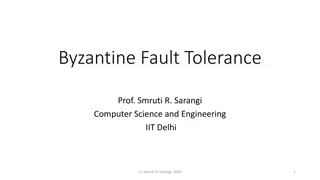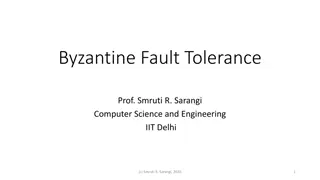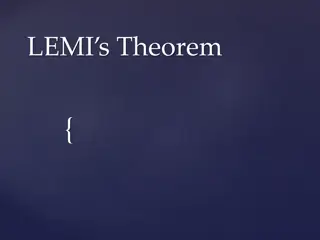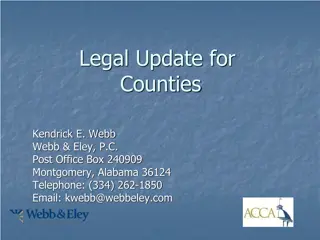Byzantine Failures and CAP Theorem Overview
Byzantine failures refer to arbitrary patterns of failures where nodes exhibit inconsistent behavior. This lecture discusses Byzantine agreement and the challenges in reaching consensus with faulty nodes. It explores the minimum number of processes needed for consensus and extends the concepts to general cases. The discussion also highlights the importance of having a sufficient number of processes to achieve agreement amidst failures.
Download Presentation

Please find below an Image/Link to download the presentation.
The content on the website is provided AS IS for your information and personal use only. It may not be sold, licensed, or shared on other websites without obtaining consent from the author.If you encounter any issues during the download, it is possible that the publisher has removed the file from their server.
You are allowed to download the files provided on this website for personal or commercial use, subject to the condition that they are used lawfully. All files are the property of their respective owners.
The content on the website is provided AS IS for your information and personal use only. It may not be sold, licensed, or shared on other websites without obtaining consent from the author.
E N D
Presentation Transcript
LECTURE 9 Byzantine Failures and CAP Theorem
Byzantine Failures Arbitrary patterns of failures not just crash failures. Specifically inconsistent messages. Primary exhibiting Byzantine behavior sending different messages to different replicas. Backup exhibiting Byzantine behavior sending message inconsistent from the input from primary.
Byzantine agreement BA1: Every non-faulty backup process stores the same value. BA2: If primary is non-faulty, then every non-faulty backup process stores exactly what the primary had sent. If primary is non-faulty BA1 BA2
What is needed ? Under these assumptions, at least 3k + 1 members are needed to reach consensus if k members can fail. Our assumptions are there is a primary P and backups B1B2 . Bn-1
Having 3k processes is not enough Let us assume k = 1 Consider the following: Case (a) primary fails; Case (b) back up fails
Having 3k cases is not enough In Case (a) primary sends T to one backup and F to one backup. Each backup forwards what is received to the other. Thus, each has {T,F} conclusion cannot be drawn. In Case (b), B1 flips the primary s message and relays a wrong (F) message to B2. B2 relays the correct message to B1. Again easy to see no conclusion.
Extension to general case For k > 1, use a simple reduction method. Group the processes into three disjoint sets each containing at most n/3 members. Simulate actions each set Sirepresents all members of its group. Thus, all members of a group are faulty or not faulty. Easy to see that this is similar to the example with k=1.
Having 3k+1 processes is enough We will only show this for the case k = 1. A similar but more cumbersome analysis possible for k = 2. We will consider two cases : Primary is faulty Backup is faulty
Consensus with 4 processes: Faulty primary Processes forward what they receive to others. In first round, P sends T to B1 and F to B2 and T to B3. Each backup sends what they have to others. Easy to see that at the end of the second round, each backup has {T, T, F}. Thus, a consensus of T is reached.
Consensus with 4 processes: Faulty backup Non faulty primary sends T to all backups. Faulty B2 sends F, while non-faulty B1 and B3 send T. We see that the two non-faulty backups have {T,T,F}.
Asssumptions For crash failures (2k+1) processes to come to consensus in presence of k failures. However, the assumption is that the delay is bounded message is received within some finite time. But what is this finite time ? If processes do not operate in a lock step mode i.e., they are asynchronous, then hard to say what latency is incurred in receiving messages.
FLP Impossibility Result 12 In asynchronous model, distributed consensus impossible if even one process may fail Holds even for weak consensus (i.e., only some process needs to learn, not all) Holds even for only two states: 0 and 1
FLP Impossibility Result 13 Intuition: Cannot distinguish failures from slowness May not hear from process that has deciding vote Implication: Choose safety or liveness Liveness availability ? B A B A How to get both safety and liveness? Need failure detectors (partial synchrony)
Recap: some terms Consistency: Every read receives the most recent write or an error Availability : Every read receives a response (not error) but no guarantee it is most recent. Partition tolerance : System operates in spite of arbitrary number of message losses or delays between the replicas.
CAP Theorem 15 Pick any two: Consistency (C), Availability (A), and Partition-Tolerance (P) In practice, choose between CP and AP Replica Replica Replica Replica Replica
What does this mean? When partition occurs: Cancel the operation Decreases availability but ensures consistency Proceed with the operation Ensures availability at the cost of inconsistency
PACELC 17 Extension of CAP to include the impact of latency. If partition, Choose availability vs. consistency Else, Choose latency vs. consistency R R R R R Unifies two separate tradeoffs that we have talked about
Why should you care? 18 Can identify when system designers over-claim Explicitly reason about tradeoffs when designing systems Example: Should you choose AP or CP?
Impact on Consistency 19 When a replica receives a read or write, when can it respond without violating linearizability? If it is in a majority partition If we want any replica to always serve clients Can we provide any consistency guarantees? Example of such a RSM?
Example Scenario 20 Calendar application running on smartphones Each entry has time and set of participants Local copy of calendar on every phone No master copy Phone has only intermittent connectivity Cellular data expensive while roaming WiFi not available everywhere Bluetooth has very short range
Format of Updates 21 Goal: Automatic conflict resolution when replicas sync with each other What would work? 10AM meeting, 4901 BBB, EECS 498 staff 1 hour meeting at 10AM if room and participants free, else 11AM, 4901 BBB, EECS 498 staff
Example Execution 22 Node A asks for meeting M1 at 10 AM, else 11 AM Node B asks for meeting M2 at 10 AM, else 11 AM X syncs with A, then B Y syncs with B, then A X will put meeting M1 at 10:00 Y will put meeting M1 at 11:00 Replicas can t apply updates in order received
Ordering of Updates 23 All replicas must apply updates in same order How to achieve consistent ordering despite intermittent connectivity? Lamport clock!
Ordering of Updates 24 Recap of Lamport clocks: Every update associated with timestamp of the form (local timestamp T, originating node ID) a < b if a.T < b.T, or (a.T = b.T and a.ID < b.ID) Updates with timestamps in our example: 701, A : A asks for meeting M1 at 10 AM, else 11 AM 770, B : B asks for meeting M2 at 10 AM, else 11 AM
Another Example Execution 25 701, A : A asks for meeting M1 at 10 AM, else 11 AM 700, B : Delete meeting M1 B s clock was slow Now, delete will be ordered before add How to prevent this? Lamport clocks preserve causality
Example Execution 26 701, A : A asks for meeting M1 at 10 AM, else 11 AM 770, B : B asks for meeting M2 at 10 AM, else 11 AM Pre-sync database state: A has M1 at 10 AM B has M2 at 10 AM After A receives and applies update from B: A has M1 at 10AM and M2 at 11AM How can B apply update from A? B already has M2 at 10AM
Solution: Roll back and replay 27 B needs to roll back its state, and re-run ops in the correct order So, in the user interface, displayed calendar entries are tentative at first B s user saw M2 at 10 AM, then it moved to 11 AM Takeaways: Need to maintain log of updates Sync updates between replicas not state
How to sync, quickly? 28 A B -,10, X -,10, X How to sync without state exchange proportional to size of log? -,20, Y -,20, Y -,30, X -,30, X -,40, X -,40, Y B tells A: highest timestamp for every node e.g., X 30, Y 40 In response, A sends all X's updates after -,30,X , and all Y's updates after -,40,Y Version vector
Consistency semantics 29 Can a calendar entry ever be considered no longer tentative? Eventual consistency: If no new updates, all replicas eventually converge to same state
Committing Updates 30 Implications of ordering updates using timestamp: Never know whether some write from the past may yet reach your node So all entries in log must be tentative forever All nodes must store entire log forever How to mark calendar entries as committed? How to garbage collect updates to prune the log?
Committing Updates 31 Update with timestamp (T, ID) is stable if higher timestamp update received from every node Problem? Disconnected replica prevents others from declaring updates stable Solution: Pick one of the replicas as primary Primary determines order of updates Desirable properties of primary?
Committing Updates 32 At any replica: Stable state Log of tentatively ordered updates (order based on Lamport clock timestamps) Upon sync with primary Receive updates in order Apply updates to stable state and prune log Any constraints in order chosen by primary? Must respect causality

 undefined
undefined
























